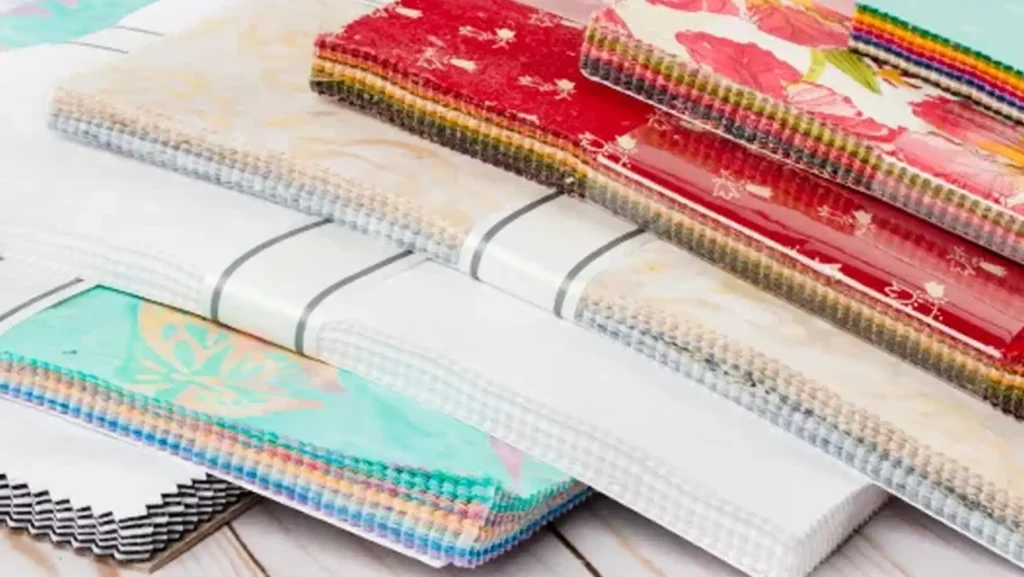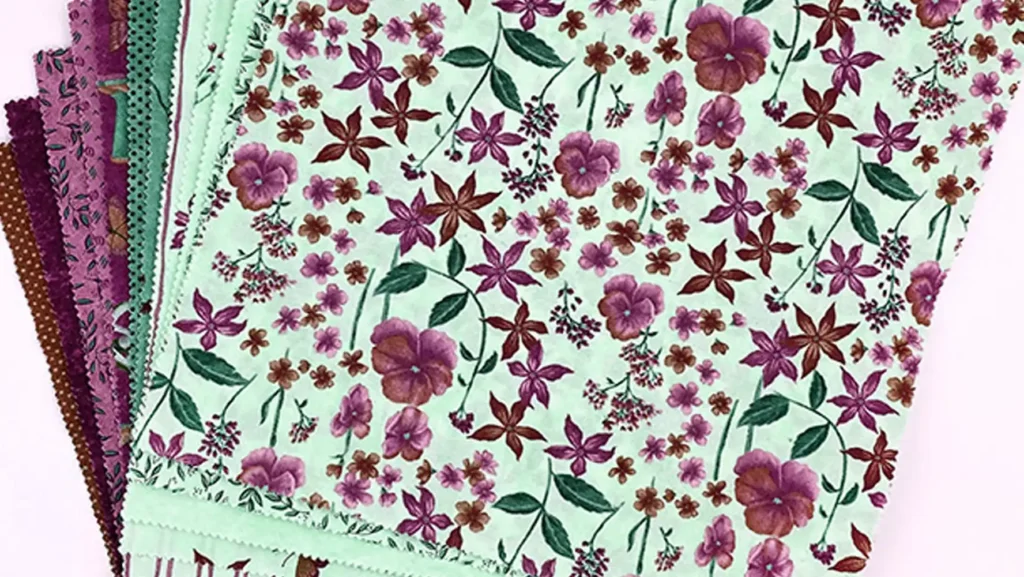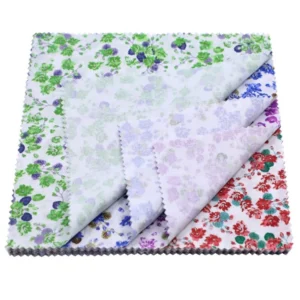For quilt lovers, finding the right fabric can be both a joy and a challenge. That’s where pre-cut fabric packs come in handy, simplifying the process while inspiring creativity. Among these delightful fabric packs, Layer Cake holds a special place in our hearts. If you’ve ever wondered what exactly Layer Cake fabric is? You’ve come to the right place! Join us as we dissect this popular pre-cut fabric and explore its ingredients, benefits, and how it can sweeten your quilting projects.
What is a Layer Cake in Quilting Fabric?

The Anatomy of a Layer Cake: Understanding This Pre-cut Delight
When we talk about “what is a Layer Cake in quilting fabric,” we’re referring to a perfectly curated bundle of fabric squares. Imagine a stack of beautifully coordinated prints, all neatly cut and ready to inspire your next quilt. This pre-cut format is designed to save quilters time and effort, eliminating the need for extensive fabric selection and cutting.
Here’s what typically makes up a standard Layer Cake:
- Size: Each square in a Layer Cake measures a generous 10 inches by 10 inches. This size is large enough to be versatile for a variety of blocks and patterns, yet small enough to be manageable.
- Quantity: A typical Layer Cake contains 42 individual fabric squares.
- Fabric Lines: The squares almost always come from a single fabric collection or “line” released by a particular designer or manufacturer. This is one of the biggest advantages, as it guarantees that all the prints and colors within the bundle are designed to coordinate perfectly with each other.
- Variety: Within the 42 squares, you’ll usually find one or two of every print from that specific fabric line. If a collection has more than 42 prints, you might get fewer duplicates or a more selective assortment. Conversely, if a line has fewer than 42 prints, some prints will be duplicated to reach the 42-square total.
This consistent sizing and coordinated selection make Layer Cakes incredibly appealing, especially for quilters who love to work with cohesive color palettes and designs without the guesswork.
Layer cakes serve as a convenient and time-saving option for quilters, as they eliminate the need for extensive cutting and fabric selection. Quilters can simply purchase a layer cake pack containing an array of complementary fabrics, allowing them to focus on the creative aspect of quilt-making rather than the tedious task of cutting fabric into precise squares.
These pre-cut fabric squares offer a harmonious selection of patterns, colors, and designs, curated by renowned fabric designers. This ensures visual coherence and coordination within a quilt project, facilitating the creation of cohesive and aesthetically pleasing quilt designs.
What Size is Layer Cake Fabric

Layer cake fabric bundles are characterized by their pre-cut squares, designed to streamline quilting and sewing projects. The standard size for a layer cake square is 10 inches by 10 inches.
These squares are typically sold in packs containing 42 pieces, though the number can vary slightly depending on the manufacturer. The appeal of layer cakes lies in their coordination; they usually feature a range of fabrics from a single designer’s collection, ensuring a harmonious palette for your creations.
While the 10-inch square is the most common, it’s important to be aware of other pre-cut fabric sizes that are also popular in quilting. Understanding these sizes will help you choose the right fabric for your project.
Here is a table of common pre-cut fabric sizes:
| Name | Size (inches) | Typical Piece Count |
| Layer Cake | 10 x 10 | 42 |
| Jelly Roll | 2.5 x 42 | 40 |
| Charm Pack | 5 x 5 | 42 |
| Mini Charm Pack | 2.5 x 2.5 | 42 |
| Fat Quarter | 18 x 21 | Varies (sold individually) |
| Fat Eighth | 9 x 21 | Varies (sold individually) |
How Much Fabric Equals a Layer Cake?
A standard Layer Cake in quilting fabric contains 42 individual fabric squares, each measuring 10 inches by 10 inches. When we calculate the total yardage this represents, we find that one Layer Cake is approximately equivalent to 2.75 to 2.88 yards of fabric.
This calculation assumes a standard fabric width of 42-44 inches. While a 10-inch square is relatively small, the cumulative effect of 42 such pieces provides a significant amount of coordinated fabric for a wide range of quilting projects, making Layer Cakes a very efficient and appealing pre-cut option for quilters.
How to Choose the Right Layer Cake

Selecting the right layer cake for your quilting project involves considering several factors to ensure the best outcome.
Here’s a guide on how to choose the perfect layer cake:
Fabric Quality: Opt for layer cakes made from high-quality cotton fabric. Quality fabric ensures durability and ease of sewing, resulting in a well-crafted quilt that withstands the test of time.
Color Coordination: Pay attention to the color palette of the layer cake. Aim for a mix of colors that harmonize well together and complement your overall quilt design. Consider the mood and theme you want to convey with your quilt when selecting colors.
Design Coherence: Evaluate the design coherence within the layer cake collection. Look for a balance of prints, motifs, and patterns that work seamlessly together. Ensure that the designs align with your quilt’s aesthetic and vision.
Compatibility with Quilt Pattern: Assess how well the layer cake coordinates with your chosen quilt pattern. Consider the scale of the prints and how they fit within the quilt blocks. Ensure that the fabrics enhance the overall design rather than detracting from it.
Personal Preference: Trust your instincts and personal taste when selecting a layer cake. Choose fabrics that resonate with you and inspire your creativity. Don’t be afraid to mix and match patterns and colors to create a unique and personalized quilt.
By considering these factors and taking the time to select the right layer cake for your quilting project, you can ensure a cohesive, visually appealing, and satisfying outcome. Happy quilting!
Popular Quilt Patterns and Projects for Layer Cakes

One of the most exciting aspects of asking “what is a Layer Cake in quilting fabric?” is discovering the myriad of projects we can create with them. Their 10-inch size makes them incredibly adaptable, allowing for everything from simple block construction to more intricate designs.
Here are some of our favorite ways to use Layer Cakes in our quilting and sewing projects:
- Half-Square Triangles (HSTs): This is a classic! We can get two 9.5-inch HSTs from a single Layer Cake square, or even more if we cut them smaller. HSTs are fundamental building blocks for countless quilt patterns.
- Four-Patch Blocks: By cutting each 10-inch square into four 5-inch squares, we can easily create quick four-patch blocks.
- Nine-Patch Blocks: Similarly, cutting into nine 3.5-inch squares allows for efficient nine-patch construction.
- Snowball Blocks: Layer Cakes are perfect for creating snowball blocks, where smaller squares are sewn onto the corners of a larger square.
- Strip Piecing: While Jelly Rolls are ideal for narrow strips, we can cut Layer Cake squares into wider strips (e.g., 2.5 inches, 3 inches, or 4 inches) to create dynamic strip-pieced units for borders, sashing, or block centers.
- Larger Patchwork Blocks: The 10-inch size is excellent for making larger, simpler blocks that showcase the beautiful prints, minimizing the number of pieces we need to sew together. Think large squares, rectangles, or even simple log cabin blocks.
- Backings for Smaller Projects: For baby quilts or wall hangings, a few Layer Cake squares sewn together can create a charming and coordinated backing.
- Appliqué: The variety of prints in a Layer Cake makes it fantastic for appliqué projects, offering a cohesive palette for your designs.
- Home Decor Items: Beyond quilts, Layer Cakes are perfect for creating coordinating pillow covers, placemats, tote bags, or even a simple patchwork table runner.
The key is to think about how the 10-inch square can be sub-cut or combined with other squares to form your desired block or design. We often find ourselves Browse patterns specifically designed for Layer Cakes, as they provide exact cutting instructions for this popular pre-cut size.ating these techniques into your quilting projects, you can harness the full potential of layer cakes and create stunning quilts that showcase your creativity and craftsmanship.
What to Make With a Fabric Layer Cake
Layer cakes are incredibly versatile, offering a convenient way to create a variety of sewing projects. Their pre-cut nature saves time, and the coordinating fabrics ensure a cohesive look. Here are some popular ideas:
Quilts:
- Layer cakes are a quilter’s dream. They’re perfect for creating patchwork quilts of various sizes, from baby quilts to king-size beds. Many quilt patterns are specifically designed for layer cakes, simplifying the process.
- Because the fabric is already cut into 10 inch squares, many traditional quilt blocks can be made very quickly.
Home Decor:
- Beyond quilts, layer cakes can be used to make:
- Table runners and placemats
- Throw pillows
- Wall hangings
- Fabric baskets.
Other Sewing Projects:
- Layer cakes can also be used for:
- Tote bags
- Pencil cases
- And many other small sewing projects.
Layer cakes provide a wonderful starting point for both beginner and experienced sewers, allowing for creative exploration with coordinating fabrics.
Tips for Working with Layer Cakes
To make the most of your Layer Cake and ensure a smooth quilting experience, we’ve gathered some of our top tips. These little nuggets of wisdom often come from lessons learned through our own quilting adventures!
- Press Before Cutting (If Necessary): While Layer Cakes are pre-cut, sometimes the edges can be slightly wavy or there might be some creases from packaging. A light press with a dry iron can help ensure accurate cutting if you plan to sub-cut the squares. Avoid stretching the fabric.
- Check for Consistency: Occasionally, there might be slight variations in size among squares from different manufacturers, or even within the same bundle. It’s always a good idea to check a few squares against your ruler if precision is paramount for your project.
- Consider Pre-Washing (Carefully): While many quilters don’t pre-wash pre-cuts to avoid fraying, if you’re concerned about fabric shrinkage or bleeding, you could carefully wash and dry one square as a test. Be aware that pre-washing can lead to significant fraying with pre-cuts. We generally skip pre-washing Layer Cakes unless we’re working with very dark, saturated colors that are prone to bleeding.
- Embrace the Cohesion: Don’t be afraid to use all the fabrics in the bundle! The beauty of a Layer Cake lies in its curated collection. Mix and match prints to create dynamic and visually interesting quilts.
- Look for Layer Cake-Friendly Patterns: Many designers create patterns specifically optimized for Layer Cakes. These patterns will often specify how many Layer Cakes you need and provide precise cutting instructions, simplifying your planning process.
- Store Them Flat: To keep your Layer Cake squares neat and wrinkle-free, we recommend storing them flat, perhaps in a clear plastic container or bag, rather than folded or crumpled.
By keeping these tips in mind, you’ll be well on your way to creating stunning projects with your Layer Cakes, truly understanding “what is a Layer Cake in quilting fabric” from a practical perspective.
FAQs
How do I care for quilts made with layer cakes?
Quilts made with layer cakes can be machine washed on a gentle cycle with mild detergent. Avoid using harsh chemicals or bleach, as they may damage the fabric. To preserve the quilt’s integrity, consider air drying or using a low-heat setting on the dryer.
Can I mix layer cakes from different fabric collections?
While mixing layer cakes from different collections is possible, it’s essential to ensure coherence in color, scale, and design aesthetic. Experiment with small swatches or create mock layouts to assess compatibility before committing to a larger project.
Is it necessary to pre-wash layer cakes before quilting?
Pre-washing layer cakes is a personal preference, with some quilters opting to pre-wash to remove any sizing or shrinkage from the fabric. However, pre-washing may affect the texture and appearance of the fabric, so it’s advisable to test a small sample before washing the entire layer cake.
How many layer cakes do I need for a quilt?
The number of layer cakes required for a quilt depends on the quilt pattern, size, and desired layout. As a general guideline, a standard lap-sized quilt may require approximately 2-3 layer cakes, while larger quilts may necessitate additional packs.
Can I use layer cakes for other sewing projects besides quilting?
Yes, layer cakes can be utilized for various sewing projects beyond quilting, including patchwork cushions, tote bags, and table runners. Their pre-cut nature simplifies the cutting process and offers a coordinated selection of fabrics for diverse creative endeavors.
Where can I purchase quality layer cakes for quilting?
Quality layer cakes can be sourced from reputable fabric stores, online retailers, or directly from fabric designers’ websites. Ensure to review customer reviews, fabric descriptions, and return policies when purchasing layer cakes to guarantee satisfaction with your selection.
Conclusion
In conclusion, the layer cake serves as a versatile and indispensable component in the realm of quilting fabric, offering quilters a myriad of creative possibilities and design opportunities. By understanding its characteristics, selecting with care, and employing expert techniques, quilters can elevate their craft and embark on fulfilling quilting journeys enriched by color, texture, and creativity.


